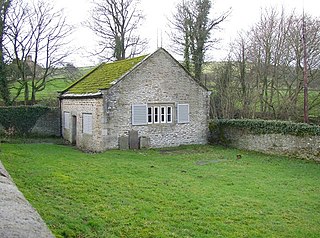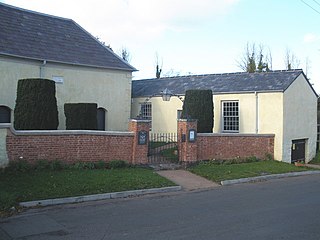
Haltwhistle is a small town and civil parish in Northumberland, England, 10 miles (16 km) east of Brampton, near Hadrian's Wall. It had a population of 3,811 at the 2011 Census.

Tabley House is an English country house in Tabley Inferior, some 3 kilometres (1.9 mi) to the west of the town of Knutsford, Cheshire. The house is recorded in the National Heritage List for England as a designated Grade I listed building. It was built between 1761 and 1769 for Sir Peter Byrne Leicester, to replace the nearby Tabley Old Hall, and was designed by John Carr.

Coanwood is a village in Northumberland, England, and is part of the Parish of Haltwhistle. It is about four miles (6 km) to the south-west of Haltwhistle, on the South Tyne. Nearby is the village of Lambley.

A Friends meeting house is a meeting house of the Religious Society of Friends (Quakers), where meeting for worship is usually held. Typically Friends meeting houses do not have steeples.

Biddlestone Chapel is a redundant Roman Catholic chapel in Biddlestone, Northumberland, England. It is recorded in the National Heritage List for England as a designated Grade II* listed building, and owned by the Historic Chapels Trust. The lower parts of the structure, a former pele tower, are designated as a Scheduled Monument. The chapel is located on the slopes of the Cheviot Hills in the Northumberland National Park.

The Cornwall Friends Meeting House is a historic meeting house located on a 5.4-acre (2.2 ha) parcel of land at the junction of Quaker Avenue and US 9W in Cornwall, New York, United States, near Cornwall-St. Luke's Hospital. It is both the oldest religious building in the town, and the first one built. In 1988 it was added to the National Register of Historic Places as a well-preserved, minimally-altered example of a late 18th-century Quaker meeting house.

The Saylesville Friends Meetinghouse is an historic Quaker meetinghouse on Smithfield Avenue within the village of Saylesville in the town of Lincoln, Rhode Island.

Amawalk Friends Meeting House is located on Quaker Church Road in Yorktown Heights, New York, United States. It is a timber frame structure built in the 1830s. In 1989 it and its adjoining cemetery were listed on the National Register of Historic Places.

The Historic Chapels Trust is a British Registered Charity set up to care for redundant non-Anglican churches, chapels, and places of worship in England. To date, its holdings encompass various nonconformist Christian denominations and Roman Catholic sites.

Farfield Friends Meeting House is a Quaker meeting house no longer regularly in use by a Quaker meeting and now owned by the Historic Chapels Trust. It is located some 2 miles (3 km) north of the village of Addingham, West Yorkshire, England. It is recorded in the National Heritage List for England as a designated Grade II* listed building..

Salem Chapel is in Vicarage Road, East Budleigh, Devon, England. Initially a Presbyterian, then a Congregational chapel, it was later owned by the Assemblies of God, and is now owned by the Historic Chapels Trust. The chapel, together with the adjacent assembly room and the boundary walls, is recorded in the National Heritage List for England as a designated Grade II* listed building. It is mentioned as the final two words of the short story, "Pomp and Vanities", written by S.Baring-Gould, circa 1865 and contained in his "Book of Ghost Stories", first published in 1903. The final two words, Salem Chapel, are referenced as an example of everything "heaven is not"!

St Benet's Chapel is a redundant Roman Catholic chapel in Chapel Lane, Netherton, Liverpool, Merseyside, England. The chapel and the attached priest's house are recorded in the National Heritage List for England as a designated Grade II* listed building. In the List it is described as "an important example of an early Catholic church and is one of the best preserved examples in the north-west". It is managed by the Historic Chapels Trust.

The Old Church of St Afran, St Ieuan and St Sannan, Llantrisant, is a redundant church in the settlement of Llantrisant, Anglesey, Wales. It is designated by Cadw as a Grade II* listed building, and is under the care of the Friends of Friendless Churches. It is set in an isolated position off a country road and is adjacent to a farmstead.

St Cuthbert's Church is a redundant Anglican church about 1 mile (1.6 km) to the southeast of the village of Holme Lacy, Herefordshire, England. It stands in an isolated position at the end of a lane in a bend of the River Wye. It is designated in the National Heritage List for England as a Grade I listed building, and is under the care of the Churches Conservation Trust.

All Saints Church, Saltfleetby, is a redundant Anglican church in the village of Saltfleetby All Saints, Lincolnshire, England. It is recorded in the National Heritage List for England as a designated Grade I listed building, and is under the care of the Churches Conservation Trust. The church stands in the marshland of Lincolnshire, and has a leaning west tower.

The Blue Coat School is located in Upper Northgate Street, Chester, Cheshire, England. It is recorded in the National Heritage List for England as a designated Grade II* listed building.

St Mary's Church, Presbytery and Convent are in Back Lane, Little Crosby, Sefton, Merseyside, England. The church is an active Roman Catholic parish church in the diocese of Liverpool which was built in 1845–47. The presbytery and convent were both built in the 18th century, and altered in the 19th century. The convent originated as a chapel, and has since been converted into a private dwelling. Both the church and the former convent with its attached presbytery are recorded in the National Heritage List for England as designated Grade II listed buildings.

The Roaring Creek Friends Meeting House is a historic place of worship for members of the Religious Society of Friends, or Quakers, in rural Columbia County, Pennsylvania, near Numidia on Quaker Meeting House Road.

Todenham is a village and civil parish in the Cotswold district of Gloucestershire, England. The village is significant for its Grade I listed 14th-century parish church.

The Church of St Cuthbert is a grade I listed building in Bellingham, Northumberland, owned by the Church of England. Parts of the church date to the 13th century and it survived the raids of the border reivers which burnt down many structures in the village. The structure consists of a nave, chancel and a large south chapel. The chancel is noted for having a remarkable roof consisting of strips of Lakeland slate. The graveyard contains the "Lang Pack", a tomb associated with a nearby country house robbery legend.




















